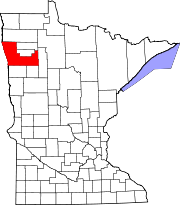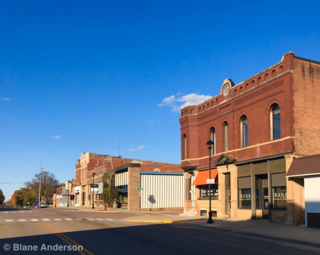
Lake Crystal is a city in Blue Earth County, Minnesota, United States. Established in May 1869. The population was 2,549 at the 2010 census. It is part of the Mankato–North Mankato Metropolitan Statistical Area.
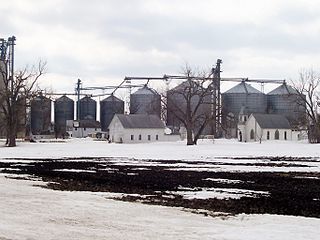
Tenney is an unincorporated community and former city in section 28 of Campbell Township, Wilkin County, Minnesota, United States. A post office was established there in 1887, and Tenney was incorporated as a city on November 30, 1901. The population was 5 at the 2010 census, tying Tenney with Funkley as Minnesota's least populous community. It is part of the Wahpeton, ND–MN Micropolitan Statistical Area. Tenney's main economic feature is a grain elevator near its southern border.
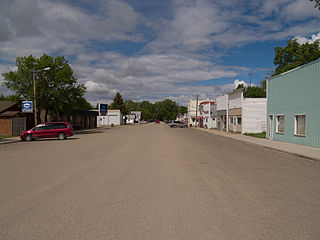
Wimbledon is a city in Pierce Township, Barnes County, North Dakota, United States. The population was 216 at the 2010 census.

Hanover is a borough in York County, Pennsylvania, 19 miles (31 km) southwest of York and 54 miles (87 km) north-northwest of Baltimore, Maryland and is 5 miles (8.0 km) north of the Mason-Dixon line. The town is situated in a productive agricultural region. The population was 15,289 at the 2010 census. The borough is served by the 717 area code and the ZIP Codes of 17331-34. Hanover is named after the German city of Hannover.
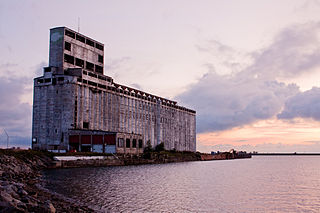
A grain elevator is an agrarian facility complex designed to stockpile or store grain. In grain trade, the term "grain elevator" also describes a tower containing a bucket elevator or a pneumatic conveyor, which scoops up grain from a lower level and deposits it in a silo or other storage facility.

The Soo Line Railroad is the primary United States railroad subsidiary of the Canadian Pacific Railway, one of seven U.S. Class I railroads, controlled through the Soo Line Corporation. Although it is named for the Minneapolis, St. Paul and Sault Ste. Marie Railroad (MStP&SSM), which was commonly known as the Soo Line after the phonetic spelling of Sault, it was formed in 1961 by the consolidation of that company with two other CP subsidiaries: The Duluth, South Shore and Atlantic Railway, and the Wisconsin Central Railway. It is also the successor to other Class I railroads, including the Minneapolis, Northfield and Southern Railway and the Chicago, Milwaukee, St. Paul and Pacific Railroad. On the other hand, a large amount of mileage was spun off in 1987 to Wisconsin Central Ltd., now part of the Canadian National Railway. The Soo Line Railroad and the Delaware and Hudson Railway, CP's other major subsidiary, presently do business as the Canadian Pacific Railway. Most equipment has been repainted into the CP scheme, but the U.S. Surface Transportation Board groups all of CP's U.S. subsidiaries under the Soo Line name for reporting purposes. The Minneapolis headquarters are located in the Canadian Pacific Plaza building, having moved from the nearby Soo Line Building.

Nixon Township is one of thirteen townships in DeWitt County, Illinois, USA. As of the 2010 census, its population was 571 and it contained 250 housing units. The last settled township in DeWitt County was Nixon. The first settlement began in 1850 and the first to locate in this township was Cicero Twist in the spring of 1850. He settled in Section 8 and that year broke a small patch of prairie and raised a crop of sod corn. There had been land cultivated within its boundaries, years before but by parties living outside the immediate area not citizens of the township. Milo Twist, one of eight, was the first white child born in the township and the Twist family lived in a crude cabin constructed of rough logs just as they were cut from native timber. George, William and Morris Nixon were also some of the most early settlers of the area. They were brothers and came from Ohio in the year 1850, settling in different parts of the township. William Nixon and Smith Fuller of DeWitt Township rode on horseback to Houston, Texas, in 1856 in order to buy 500 sheep each. They drove the one thousand head of sheep back to eastern DeWitt County and were the first farmers in the community to have cattle and sheep grazing on the prairies where Weldon now stands. A.M Pue broke the first prairie sod and raised the first crop of corn. In 1859, at the time of the township organization, the commissioners gave the township the name of Nixon in their honor. John Manlove and a brother-in-law, Hiram Chandler, were also early citizens. C S Lisenby improved land in the early days of the township but resided in Creek Township. A Rush and Kate Shipman were the first couple married in the township. John McGinnis was the first postmaster of Nixon Township. The post office was located and housed in a room of an old house on the farm where Duane Riddle later lived in the 20th century. Grains of corn, wheat and oats were to become the main cash crops and were delivered to market by wagon westerly to Clinton and northeast to Mt. Pleasant. During the frozen seasons, delivery was made to Decatur by wagon on roads, or sled on the ice of Friends Creek, running in a southerly direction to the Sangamon River, and to the processing plant of A E. Staley Co Grain. Cattle were also hauled and driven overland to Chicago. On one crossroad a store, blacksmith shop and a schoolhouse formed the first settlement of Shoo Fly and was directly northeast of the present village of Weldon. With many bushels of grain and many head of cattle to be marketed, accompanied by a demand for raw materials, a railroad was soon found to be needed. At this time the government entered the picture and gave every sixth mile of land to a division of the Wabash, St Louis & Pacific Railway. This was used to form a railroad called "The Peanut Line," which ran from Champaign to Havana, Illinois, a total of 110 miles. The history of this railroad dates from the incorporation of the Monticello Railroad Co. on February 21, 1861. The line from White Heath to Havana, an extension from Monticello to Decatur, was completed by the Havana, Mason City, Lincoln & Eastern Railroad. The village there was named in honor of Lawrence Weldon, a prominent lawyer of Bloomington, Illinois, who was also an attorney for the railroad, and took an active part in determining where the railroad would be built. In 1872 a town of Weldon was laid out adjacent to the railroad, and stores were built one block north of the present main street. This section was destroyed by fire in the summer of 1879 and new stores were built at the present location. The village of Weldon, Illinois, was surveyed and platted by surveyor John Brown, in the spring of 1872. It was placed on record in the fall of 1873, by Colonel Thomas Snell, Charles S. Lisenby, James Alexander and James DeLand. Charles S. Lisenby, rich landowner, sold his land in parts, invested in and helped develop the village of Weldon. The first two-story home was built by Lisenby in 1872. The first church started in 1872, on land donated by Colonel Snell, for that purpose. The first store was built in 1873. The Winslow Brothers operated this store. The first stock consisted of drugs and groceries, but soon merged into a general store. The building was a framed construction, 20 by 60 feet and two stories high. It was located between Water and North Street. It was destroyed by fire in the summer of 1879. The next stores were built on the next block south, which is known as High or Main Street. Grains of corn, wheat and oats were to become the main cash crops and were delivered to market by wagon westerly to Clinton and northeast to Mt. Pleasant. During the frozen seasons, delivery was made to Decatur by wagon on roads, or sled on the ice of Friends Creek, running in a southerly direction to the Sangamon River, and to the processing plant of A E. Staley Co Grain. Cattle were also hauled and driven overland to Chicago. On one crossroad a store, blacksmith shop and a schoolhouse formed the first settlement of Shoo Fly and was directly northeast of the present village of Weldon. The next several years Weldon was a very progressive little town. It boasted two hotels, two general stores, a grocer, two restaurants, a confectionery, a meat market, a drug store, one millinery shop, operated by Nora Reed (Baker), two barber shops, a lumber and coal yard and three grain elevators. The first blacksmith shop was built in 1873. It was operated by James Paulson. The first hotel was built and operated by John Bennett in 1874. The first postmaster of Weldon was J. C. Coulter, in 1873. The post office was located in the depot. At that time, Weldon's inhabitants numbered about 600. It was one of the most progressive and best conducted villages of its size in the state. C. J. Seaborg was the operator of a wagon and carriage factory, established in 1874. It is said that some of Weldon's first autos were assembled in his shop. There were stockyards in the west part of town, J.H. Scott and Robert Given being two of the early buyers, driving the livestock to town on foot. Mrs. J.T. Thomas owned a loom and in her home she wove many rag carpels, which were sold around Weldon. Mr. George W. Baker sold furniture, farm implements, silverware, jewelry, etc., in his store. Mr. Baker was also the local undertaker. There was also a men's clothing store for many years. A bank was first organized as a private concern by Jacob Swigart in 1887. It was later organized as a state bank in 1906, with Carl Swigart as president, D.M. Smallwood, vice president, H.T. Swigart, cashier, and Charles C. Lisenby, assistant cashier. Weldon was incorporated in 1892. The first meeting of the board of trustees of the village was held in Worship Gray's office, August 15, 1892. T.C. Byland presided, A.M. Drew, C.J. Seaborg, Robert Given and J.H. Scott were the board members, with C.L. Townsend as clerk. On a motion by Dr. Drew, seconded by C.J. Seaborg, a committee was appointed to draft a municipal code for the government of the village of Weldon. Robert Given, T.C. Byland and J.M. Scott were appointed to draft this code. It was voted that the ordinance of Clinton be adopted as much as would pertain to the village of Weldon. The records show that T.C. Byland was paid $15.00 for writing it. Plans were soon made to build many board walks, also a town house, a prison or a calaboose. A calaboose was needed as there were three saloons at this time or soon after. The calaboose was built on a lot belonging to William Gray, purchased by the village for $25.00. Labor to build the building was $23.75. The lumber was hauled from Clinton, with horses. More information may be found at https://dewitt.illinoisgenweb.org/nixon.htm and at http://www.archive.org/stream/honortoourherita00weld/honortoourherita00weld_djvu.txt
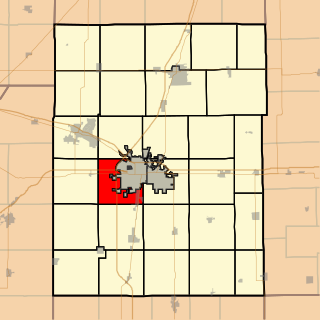
Champaign Township is a township in Champaign County, Illinois, USA. As of the 2010 census, its population was 10,834 and it contained 4,964 housing units.
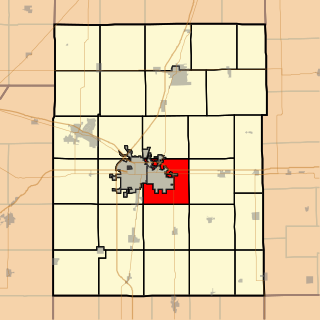
Urbana Township is a township in Champaign County, Illinois, USA. As of the 2010 census, its population was 7,451 and it contained 3,435 housing units.
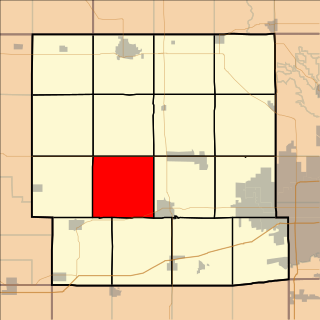
Colfax Township is a township in Dallas County, Iowa, United States. As of the 2000 census, its population was 403.
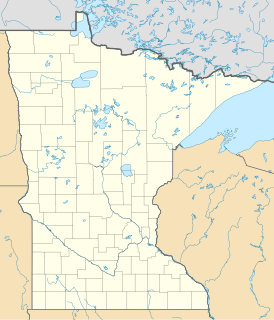
Radium is an unincorporated community in section 19 of Comstock Township, Marshall County, Minnesota, United States. It was built alongside the Minneapolis, St. Paul and Sault Ste. Marie Railroad branch line built in 1905 from Thief River Falls, Minnesota, to Kenmare, North Dakota. The place was named for the element radium. Radium had its own post office from 1905 to 1984. Since 1984, Radium has been served by the post office in Warren. It is also on the Warren telephone exchange and part of the Warren-Alvarado-Oslo school district. The townsite is being slowly reclaimed for use as farmland. There is still a large grain elevator on the railroad line south of the townsite. A small Lutheran church 1 1⁄2 miles (2.4 km) south of the town antedates the coming of the railroad; Immanuel Lutheran Church (LCMS) was organized in 1897.

Autwine is a former town in Kay County, Oklahoma, United States, formerly known as Pierceton and Virginia City. It had a post office as Pierceton from May 26, 1894 and as Autwine from March 5, 1903 until June 30, 1922. The town declined as an agricultural center after better roads in the area led to farmers taking their business to the larger business centers. Today, there is nothing left of the old townsite and the area is used for agriculture.

Cecil Township is a civil township in Bottineau County in the U.S. state of North Dakota. As of the 2000 census, its population was 28.
The lost towns are a group of places that are still commonly used by county residents. Each was at one time a post office, a store that served a part of the county, a grain elevator used by farmers to ship their crops, or a development that was or may still remain a unique designation. There may be a residential association or some other legal body devoted to the area. More often, these communities are communities of people who still refer to their homes by these geographic designations.
Org is an unincorporated community in Nobles County, Minnesota, United States.

Delft is an unincorporated community located in Cottonwood County, Minnesota in Carson Township.

Mollie is an extinct American village in Blackford County, Indiana, that flourished during the Indiana Gas Boom from the 1880s until the 1920s. The region around Mollie experienced an economic "boom" period because of the discovery of gas and crude oil. Mollie was a stop along the Fort Wayne, Cincinnati, and Louisville Railroad—and happened to be near the region's oil fields, a convenient location for the area's oil workers.
Red Top is an unincorporated community in Idun Township, Aitkin County, Minnesota, United States.
Linby is a populated place in Jefferson County, Iowa, USA.

The Midland Continental Railroad is a defunct shortline railroad which operated in the U.S. state of North Dakota between 1906 and 1966. The railroad was originally envisioned as a trunk line to run from Winnipeg, Manitoba, Canada to Galveston, Texas, on the Gulf of Mexico coast of the United States. Financing problems led to only two segments totalling 77 miles (124 km) being completed.

















